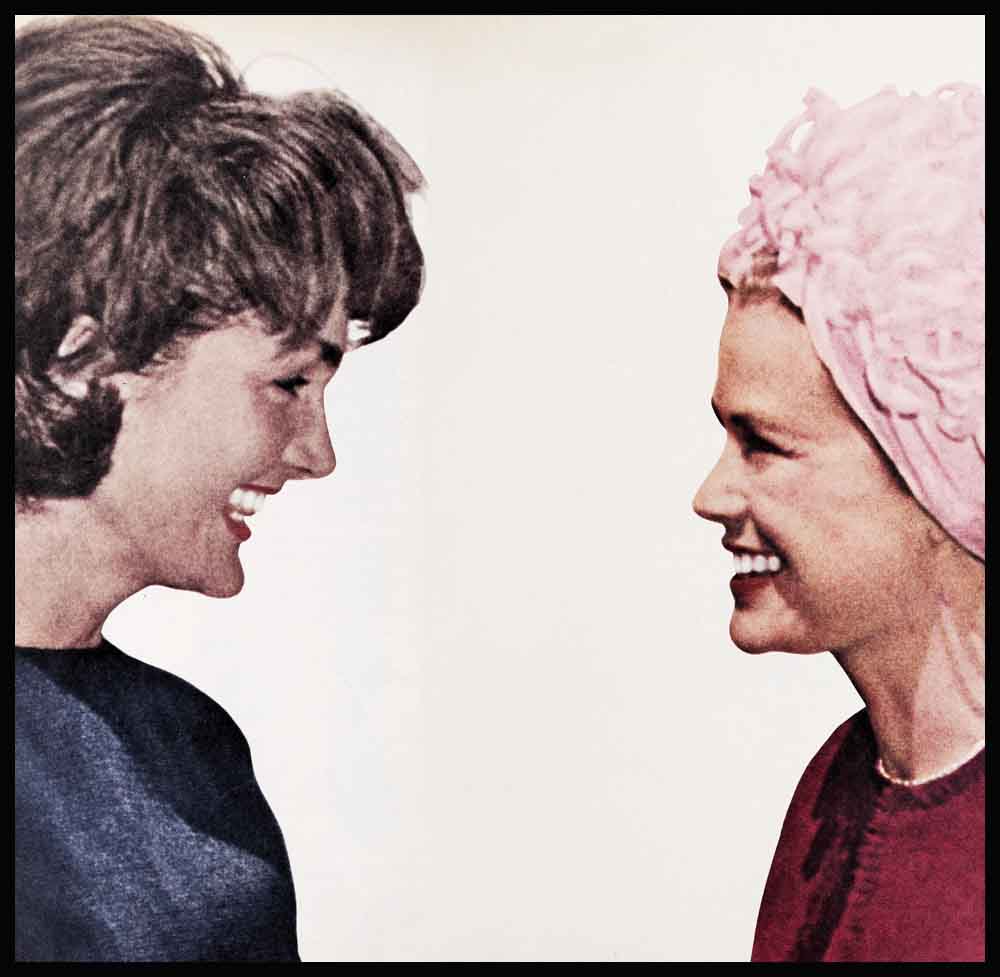
Is Grace Kelly Jealous Of Jackie?
The talk of jealousy between Grace Kelly and Jackie Kennedy, according to the latest gossip, was inevitable. The competition between the two women broke out into the open when Grace, in obvious imitation of Jackie’s informative TV tour of the White House, guided millions of curious television viewers on “A Tour of Monaco.”
A few months before that, columnist Cholly Knickerbocker outlined the events leading up to what is said to be the clash:
“The charming candid pictures of vacationing Jacqueline Kennedy, and the result- ant good will, are said to have started Prince Rainier to thinking about effecting an image of a ‘new’ Princess Grace. This ‘new’ Grace sounds very much like the ‘old’ American Kelly of pre-royal days—minus, of course, a career. But the photos of Jacqueline—particularly those with Caroline surrounded by local children—have (coincidentally?) coincided with the activities of the ‘new’ Princess Grace, who recently invited forty Algerian children to vacation in Monaco. Now Princess Grace treks to the Monte Carlo beach with her children, un- accompanied by an everybody-else-out-of- the-pool whistle to clear the sands. Her subjects were more impressed, however, by her ‘drop-in’ visit to the modest home of a typical family. She cradled the family’s youngest in her arms, made ‘house-wifely’ conversation. Yes, ‘public relations’ are certainly improving at the Palace in Monaco.” But previous to that there were some rumored skirmishes. Some were serious, some were silly. At times newspapermen and columnists fanned the flames of any rivalry that might exist by printing far-fetched comparisons and contrasts between the two. Not that Jackie or Grace ever let on there was tension or envy. Ladies like Grace and Jackie don’t do that.
AUDIO BOOK
Skirmish #1. (Or, “Pictures Don’t Lie—or Do They?”) A photograph of Grace Kelly gazing adoringly at Jackie’s husband, John F. Kennedy, is reproduced in a widely-circulated book. Under the news picture is the kittenish caption, purportedly Grace’s very own wistful words: “. . . and I had to settle for a Prince.”
Skirmish #2. (Or, “The Indecisive Battle of the Department Store Windows.”) In an open attempt to make window and store dummies more lifelike, the mannequin industry is turning to big-name inspirations—among them, of course, are both Grace and Jackie.
Mary Brosnan, head of a firm that produces elegant dummies, proclaimed last year, “Our latest success incorporates Grace Kelly’s nose with Elizabeth Taylor’s lips and eyes.” Not exactly star billing for Grace to share a window (and a face) with Liz. Jackie, on the other hand, has been able to achieve protection from this invasion of privacy.
For as Leslie Lieber wrote in This Week, “One New York outfit came a cropper when they brought out a line of ‘Jackie Kennedys.’ Most of their clients turned down the idea of making the First Lady a store-window dummy.
“A Copenhagen manufacturer had the same idea, and advertised Jackie Kennedy mannequins for European display. The United States State Department lodged a polite but firm protest through indirect channels, and the mannequins in question will soon emerge as Gina Lollobrigida.”
Skirmish #3. (Or, “The Eyes Have ‘it.’”) The Princess gave the eyeglass industry a boost by appearing in public wearing horn-rimmed glasses at the Monte Carlo Opera House and while reviewing the Monaco Palace Guard. She revealed that she was nearsighted and she set a new trend. Convinced by her action that Princes often make passes at gals who wear glasses, thousands of European shopgirls for the first time gained the courage to put on their own spectacles in public.
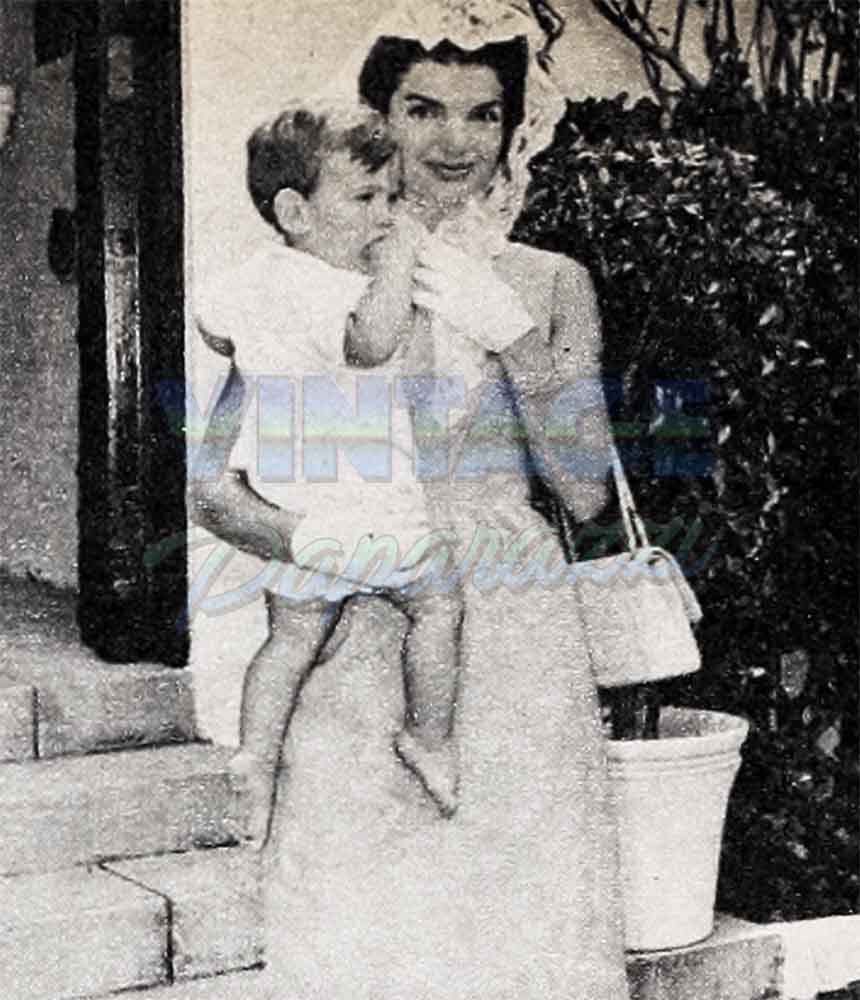
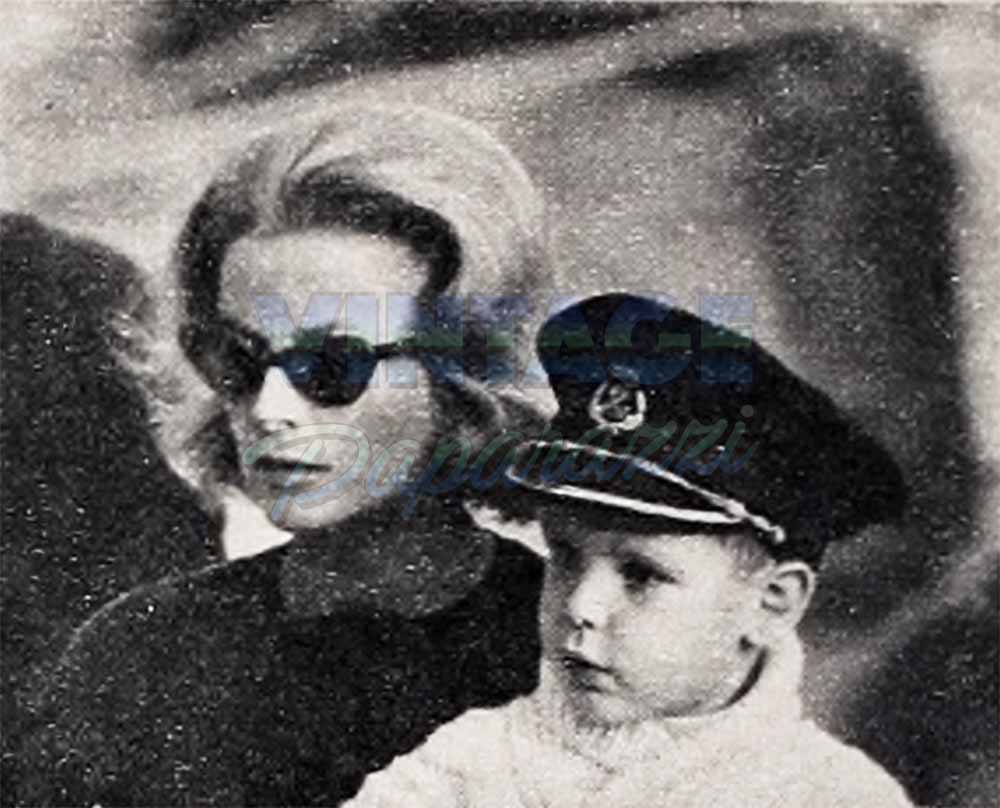
But Jackie had already set a trend in smartness in her choice of glasses. As Dorothy Kilgallen informed her New York readers, “Now you can buy ‘The Jackie Look’ in cheaters. Midtown optical shops are doing a rushing business in sunglasses that look like the ones the First Lady wears when taking the sun.”
Skirmish #4. (Or, “An Egghead Should Brush Her Hair with an Egg-beater.”) All over America women emulate the way their First Lady dresses, with delightful results. But it seems that in Europe the press is out to fan the flames of any rivalry that might exist by denouncing that look in favor of the “Grace Kelly look.” Hark, for instance, to the acid commentary of London Daily Express fashion editor Jill Butterfield as she predicted last spring that the “Jackie Kennedy Look” was on the way out and that the “Grace Kelly Look” would be in by summer.
“Kelly girls have hair that looks as if it actually grows on the head, instead of being whipped up there by an eggbeater,” Miss Butterfield meowed. “The Kelly look is the look of tomorrow, while the smiling, hard-working American First Lady climbed on a fashion bandwagon which had been turning for quite a while before her grin and gaiety gave the pillbox hat, bouffant hairstyle, campus-cute suit, and hot, bright colors a new fillip.” (“The Kelly Look,” incidentally, is defined as being mild and milky in color, featuring simple suits, skirts and classical drapes, which “are easier to spend the summer in than the straight little tight dress which is the Kennedy uniform.”)
Skirmish #5. (Or, “Wherever Jackie Goes Grace Must Follow.”) The charge is that Grace insists on following in Jackie’s footsteps (seven-league boot-steps would be more accurate) along the diplomatic trail. Grace made state visits to France, Ireland, Italy, Switzerland and the Vatican. But she hasn’t yet caught up to Jackie, who has journeyed to all those countires (except Switzerland, of course, where Liz Taylor rules, and a touchy question of protocol might arise), and in addition, visited Greece, Pakistan, India, Mexico, Canada and some Latin American countries besides.
Skirmish #6. (Or, “My Husband Is More Everything than Your Husband.”) Says Jackie about her husband: “He always seems so right.” Says Grace about her husband: “His word is law.”
Skirmish #7. (Or, “Who Said it Originally and Who is the Echo?”) Says Jackie: “I’ll be a wife and mother first.” Says Grace, on the same subject: “My husband and my children are my prime interest and have first call on my time.”
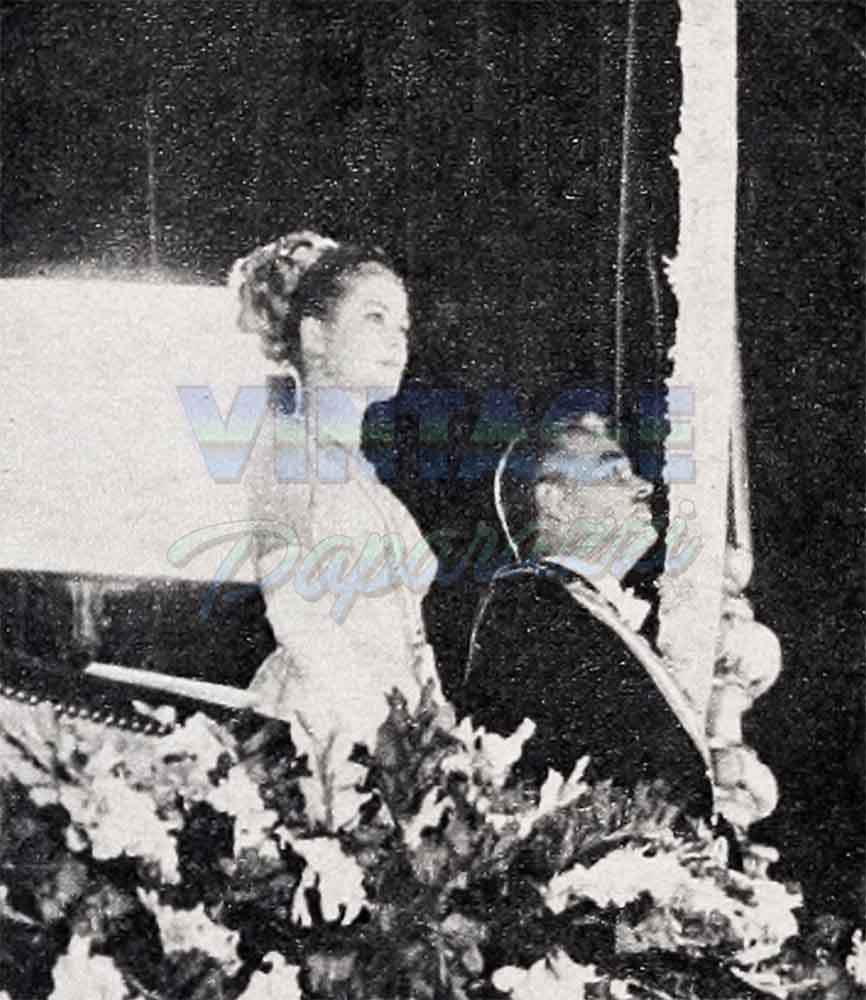
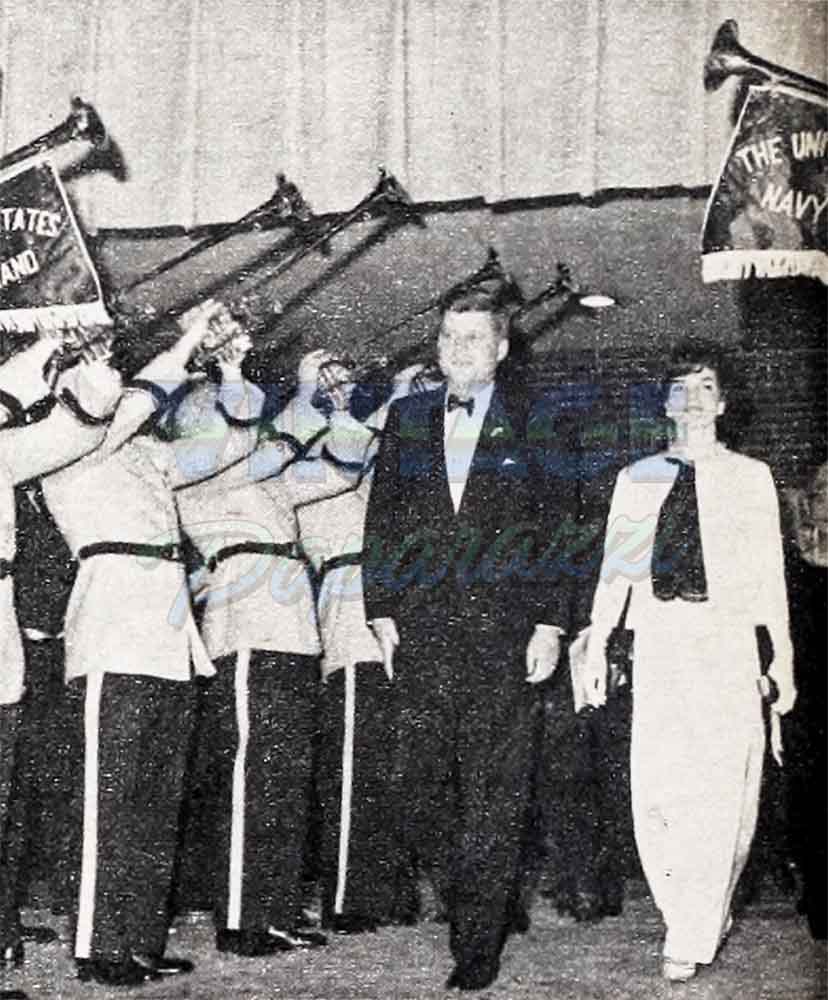
Skirmish #8. (Or, “The War of the Roses.”) Much has been made of Mrs. Kennedy’s love of flowers and her skill in arranging them. Chief White House Gardener Robert M. Redmond reported, “One of the first things Mrs. Kennedy said to me when she came into the house was to get rid of all the potted plants.” The charming, casual flower arrangements —and, unlike her predecessor, Jackie put enough ash trays everywhere—made a hit when the Kennedys gave their first White House reception.
Grace replaced the Palace potted plants with fresh cut flowers, after becoming First Lady of Monaco, and ordered that r cigarette boxes always be kept filled (she, unlike Jackie, doesn’t smoke herself) and that plenty of ashtrays be available. Gossips wondered aloud how she felt when Jackie ran her house the same way.
Skirmish #9. (Or, “Last One in the Pool is a Rotten Egg.”) The way the publicity spotlight keeps focusing on the Kennedys’ activities above, on and under water, you’d think that the New Frontier was really the Wet Frontier and that they’d first invented H2O.
Now see what happened when Elsa Maxwell threw a fabulous costume ball to celebrate the opening of an indoor swimming pool at Monaco’s Hotel Paris. As chronicled by writer Maurice Zolotow, “Rainier disguised himself in a long black mustache and a hairless wig that made him look like a bald-headed Sicilian. Princess Grace put on a rubber false-face mask, gruesomely ugly, and wore a floppy straw hat with fake hair braids dangling down. On her feet were two large flippers. The guests wined and dined and watched fireworks and, at 4:00 A.M., began swimming.
“ ‘Princess Grace,’ reported Miss Maxwell, ‘put on her flippers and swam like a fish, as did Prince Rainier.’ ”
Skirmish #10. (Or. “Which Lady is the Movie Star?”) Grace had to give up her career as an established film actress when she became First Lady of Monaco. But Jackie made a movie, “Jacqueline Kennedy’s Asian Journey,” which was released by the United States Information Agency in twenty-nine languages to 106 foreign countries, as well as this country.

So from all these incidents, a pattern emerges: a pattern of rivalry. But for one woman to try to emulate another is not, gossips and columnists to the contrary, the same as having one woman jealous of another. To compete as First Ladies, as wives and as mothers, as beauties, as fashion leaders, as homemakers and home renovators, as hostesses, as unofficial diplomats, as devotees of culture, as supporters of charity, as devoted religionists and as representatives of American womanhood does not necessarily imply jealousy.
Let’s put one of these alleged skirmishes back into context and see what it really amounts to. That photo of Grace gazing adoringly at JFK, with the insinuating caption underneath: (Grace) “. . . and I had to settle for a Prince.”
Now the fact is that the words Grace is supposed to have said were something dreamed up by a writer or editor trying to be funny. The picture-caption appeared in a satiric book, Who’s In Charge Here?—in which actual news photos were juxtaposed with far-out absurd “quotations.” (Another example: news shot of Indian Prime Minister Nehru in a white uniform: below it the caption—“Sorry, we’re all out of cherry vanilla.”)
But the photo itself, you say, how about the photo? You can’t fake adoration unless you cut Grace out of a picture in which she’s looking adoringly at her own husband and then splice it to a shot of Jack Kennedy.
True. The news shot is authentic. It was taken. Grace did look at Jack that way. But the word “adoringly”—that was the gossips’ word; it might just as well have been “intensely” or “lovingly” or “friendly.” Or “near-sightedly.”
The photo was shot on May 24, 1961, at the White House when the Kennedys entertained the Rainiers at an informal luncheon, and was reproduced on page one of Time and on a full page of Life.
Fine. But what about the look on Grace’s face as she gazed at Jack? Let’s say that Grace gave Jackie’s husband a “significant” look.
But what is its “significance”? The simple truth is that Grace and Jack are old friends. In fact, Grace is an old friend of Jack and Jackie. For it was back in 1946 that Grace Kelly had first gazed at Jack Kennedy—and at the time she was looking at a man who seemed to be dying. He’d had several serious spinal operations. Last rites had been administered.
He survived, but the convalescent period was a nerve-wracking one. Was the operation a permanent success? If the patient lived, could he ever walk again?
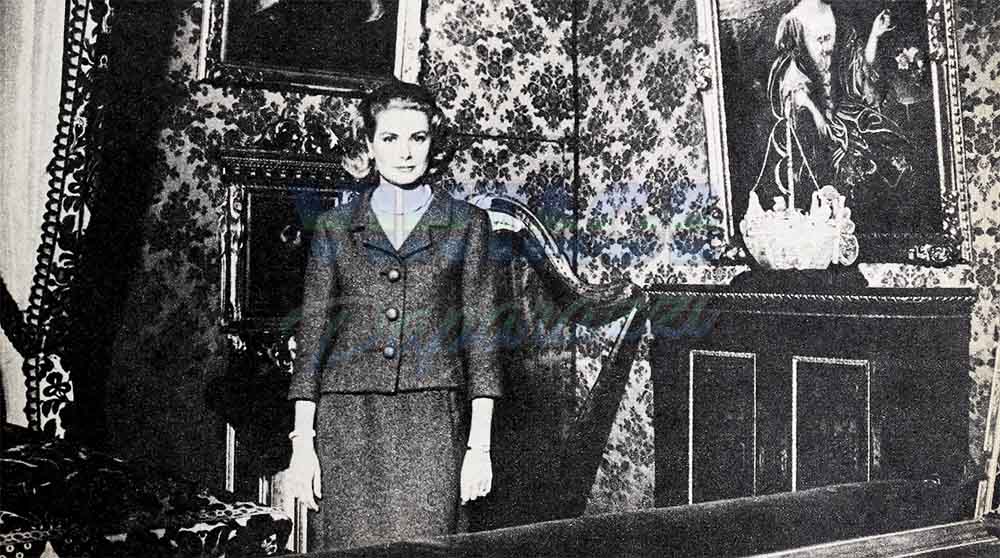
Grace meets Jack
It was during this period that Jackie, having exhausted her resources for cheering him up (she read to him, drew crazy pictures for him, brought him idiotic presents), met her friend Grace Kelly. Jack wasn’t allowed any visitors except members of the immediate family, but this didn’t stop Jackie. Her husband was in severe pain, down in the dumps and irritable. Wifely shock therapy was indicated.
So she went with Grace to the hospital and tapped on Jack’s closed door. From inside came a cross between a snarl and a growl, a warning that the patient wanted to be alone with his own dismal thoughts and that whatever nurse, attendant or intern who was disturbing him should have the good sense to go away—and quick.
But Grace Kelly entered anyhow, with Jackie right behind her. “I’m the new night nurse!” Grace announced. Jack blinked his eyes, and then he laughed out loud. Jackie, hearing this welcome sound, was most grateful. At long last Jack was able to laugh. Now she knew that somehow he was going to be all right.
It was shared experiences like these—and an amazing similarity of background and outlook—that made these two women such close friends. Born within two years of each other and growing up just 200 miles apart, Grace and Jackie were both victims of abnormal shyness, and yet both found the strength to break away from the cocoonlike existence in which they were sheltered and protected to try their wings in a threatening and challenging world.
Grace was a slender, silent, sensitive girl in an energetic, outgoing, competitive, athletics-loving family (the Kellys in many respects resembled another famous Irish-Catholic family, the Kennedys). Grace’s mother, a leading athlete and an instructor in physical education at the Woman’s Medical College, had this to say many years later about her daughter. “There was something different about Grace. She was a frail child and sickly.”
Frail, sickly and shy. Even after she mustered up the nerve to leave the cloistered finishing-school world of Ravenhill Academy and Stevens and to strike out for New York on her own, where she studied drama (as a further assertion of independence she paid her way by modeling), Grace seemed scared of the world. John Cassavetes, now a successful Hollywood actor and director but then also a fledgling performer, remarked at an American Academy of Dramatic Art graduation party, marking the end for both of them of two years of study, “That Grace Kelly’s such a pretty little thing. Isn’t it a shame she’s too shy ever to amount to anything?”

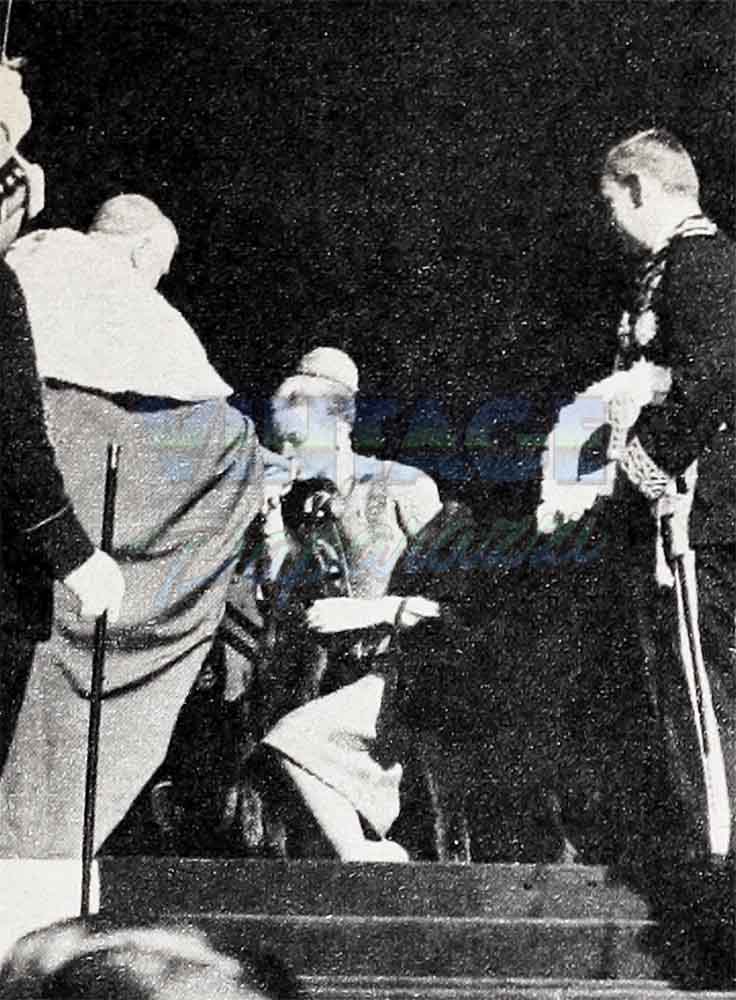
There was also something different about Jacqueline Bouvier Kennedy when she was a young girl. Her litmus-paper-like sensitivity, her own special brand of shyness, were probably intensified when her father, whom she adored, was divorced from her mother. But her stepfather, country squire Hugh Auchincloss, was to provide her with a haven and sanctuary at his secluded Merrywood estate in Virginia. It was, says playwright Gore Vidal (a relative of Jackie by marriage), “a world of deliberate quietude removed from 20th- century tension. . . . It was a life that gave total security, but not much preparation for the real world, which burst on us as a Great Adventure, a Big Discovery. Most of us broke away; Jackie surely rejected the Great Lady tradition.”
At eighteen Jackie was the “Queen Debutante of the Year”; yet just one year later she was dissatisfied, unwilling to be just a piece of pretty, fragile and use- less Dresden porcelain. Not so long ago, looking back at that period, she said, “But Newport—when I was about nineteen, I knew I didn’t want the rest of my life to be there. I didn’t want to marry any of the young men I grew up with—not because of them but because of their life. I didn’t know what I wanted. I was still floundering.”
Unlike Jackie, Grace Kelly thought she knew what she wanted. Fame. Recognition as an actress. Success.
She got a small part on a Broadway show. Then, for a long time, nothing.
Even after she achieved success, recognition and fame in Hollywood beyond her fondest dreams, she was still lonely. She was waiting . . . waiting . . . for exactly what, she did not know.
Jacqueline Bouvier’s floundering took her to Vassar for two years, then to Paris for a year at the Sorbonne, and then back to the United States where, determined not to be “a little girl at Vassar again,” she took a journalism course at George Washington University.
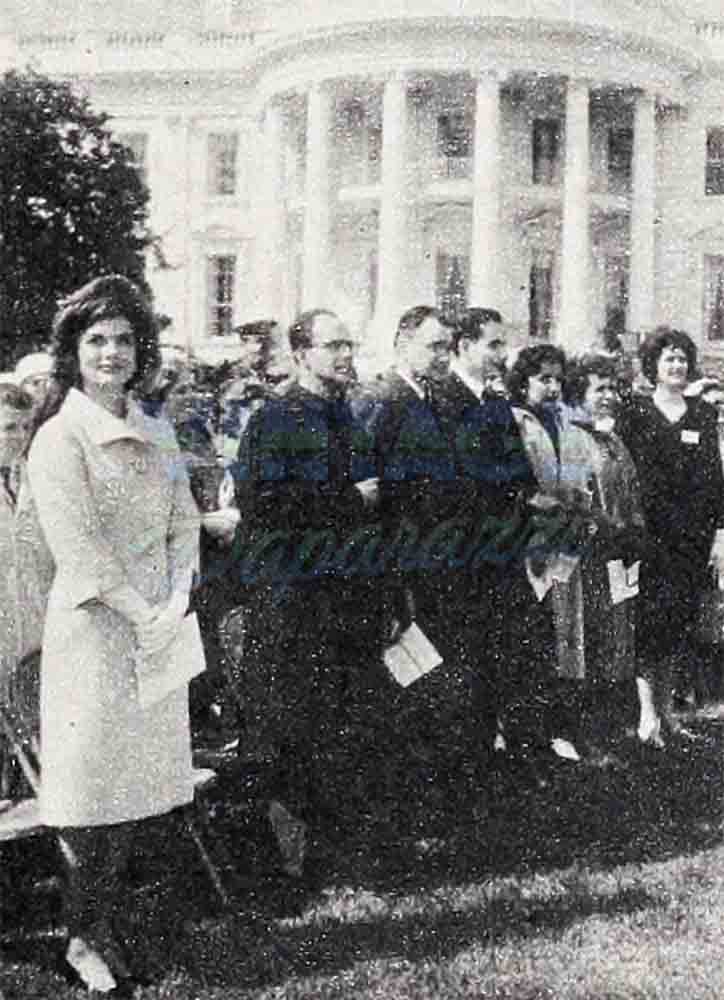

It was time. Jackie told herself, to see what the “real world” was like, so with the help of old-friend-of-the-family Arthur Krock, chief of The New York Times’ Washington bureau, she wangled a job on the Washington Times-Herald. When Krock phoned that paper’s managing editor and was told there was a $42.50-a- week opening for an inquiring photographer who could handle a camera, he put his hand over the receiver, repeated this to Jackie and asked her if she could take pictures.
Jackie gulped, crossed her fingers to take the sting out of her lie, and said, “Yes.”
Newspaper work was exciting and interviewing and taking pictures of the man-on-the-street and the celebrity-in-the-lime-light (once staff photographer Joe Heiberger had showed her how easy it was to snap pictures: you just set your camera for six feet and take all shots from that distance) was fun.
Yet there was something lacking, and it began to intrude itself unconsciously (or was it consciously?) into her column. Her inquiring reporter questions dealt more and more with love. Questions like: “Is your marriage a fifty-fifty partnership, or do you feel that you give more?” and “Can you give any reason why a contented bachelor should get married?”
To this last question, Jackie found that she herself could come up with lots of reasons. The bachelor she had in mind was handsome Jack Kennedy, senator from Massachusetts. In fact, when she framed another question in her column, people who knew Jacqueline Bouvier best were convinced she was trying to tease (and to goad?) Jack. The column question: “The Irish author, Sean O’Faolain, claims that the Irish are deficient in the art of love. Do you agree?”
The men and women to whom Jackie asked this question agreed and disagreed. But Jack Kennedy, who read Jackie’s column every day, showed his disagreement by his actions. The art of love meant showing your girl that you’re sincere, like buying her books she should read, instead of gifting her perfume, and giving her gifts that were educational instead of frilly. The art of love meant letting her know how you felt about her, nothing gooey and gushy, mind you, but a simple, straightforward statement, like sending her a cable when she was in England covering the coronation of Queen Elizabeth II, saying: ARTICLES EXCELLENT, BUT YOU ARE MISSED. The art of love meant reversing roles and asking the inquiring camera girl a question and having her answer, “Yes.” The art of love meant forsaking the alleged benefits of bachelorhood for the responsibilities and joys of marriage.
For Grace Kelly, too, her moment of fulfillment and end of loneliness came the day the S.S. Independence delivered her to Prince Rainier’s yacht and she stepped into the arms of her husband-to-be.
Love and marriage brought Grace and Jackie their true “vocation” of being wives and mothers. Yet, because both women had married extraordinary men, their vocation was soon extended to cover a much wider range than home-making and child-bearing. Immediately for Grace, and a few years after her wedding for Jackie, they both became the First Ladies of their countries. Serving society instead of Society, it was inevitable that their skills and accomplishments as hostesses, diplomats, fashion setters, beauties, patronesses of culture. sponsors of charities, sports- women, etc., etc., should be contrasted and compared.
And it was inevitable that they should compete. Actually, the very fact that they had so much in common—social position, family background, shyness, education, religious training, deep concern for art, music and literature—made this competition possible. Healthy competition, not destructive competition. The kind of competition possible only between two people who deeply respect each other. Not the “anything you can do I can do better” sort of jockyeing for position, but the “what are you doing for your husband, your children, your country that I might adopt and adapt and make my own?”
As for the gossips’ inference that Grace Kelly might be jealous of Jacqueline Kennedy—as you can see, there is no jealousy. Only a coinciding of activities of two women who have a lot in common and a big job to do—and want only to do it well.
—JIM HOFFMAN
It is a quote. PHOTOPLAY MAGAZINE JUNE 1963
AUDIO BOOK




